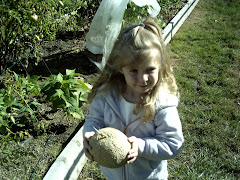Supplies to yield approximately 1/4 cup Queso Blanco:
2 cups milk (we drink 2% so that is what I use)
1 to 2 teaspoons white vinegar
non-aluminum sauce pan
thermometer, I use my digital meat thermometer
spoon
small square of muslin or very fine cheese cloth
sieve
extra pan or bowl to catch whey
The process is extremely simple. Since I only wanted a small amount of Queso Blanco to use for dinner in stir fry, I started with 2 cups of milk. You may make a larger amount of Queso Blanco by simply using more milk and vinegar.
Place the milk into a sauce pan. Place the thermometer into the pan and slowly bring the milk to a temperature of 180 to 185 degrees and cook for 5 minutes. Keep the heat low so the milk does not scorch on the bottom of the pan.

You will see a thin layer of scum develop on top of the milk. After 5 minutes using the spoon, skim off the scum and discard. Now pour the vinegar into the warmed milk and stir. You should see curds (lumps) develop immediately. If needed to get a good curd, add a little more vinegar 1/2 teaspoon at a time. The liquid which separates is known as whey.

Place the muslin or fine cheese cloth into the sieve over a container to catch the whey. Now pour the curds and whey into the muslin. Allow to strain until all the whey is removed. The result will be a white, sort of rubbery cheese.

The resulting whey will have a slight green tinge. The whey contains a lot of nutrition as well and can be used in place of water when cooking. Refrigerate both the Queso Blanco and whey until ready to use or you can freeze both.
Queso Blanco is a great way to use up milk that is soon to expire. I usually purchase milk by the gallon because it is the same price as a half gallon, but since my husband and I do not drink a lot of milk, before it was going to waste. Also, milk is extremely inexpensive right now in our area. Just last week I purchased 3 boxes of cereal and received 3 gallons of milk for free. Knowing there is no way we would use up the milk before it expires, I thought it would be the perfect time to start making and freezing Queso Blanco for use later when milk will cost more.
Dinner tonight will be vegetarian stir fry with Queso Blanco over rice made with the whey....yum! I hope you give Queso Blanco a try and if you do let me know how it worked out for you. Kim
Just wanted to add another note (4/8/09) last night for dinner I used some of the Queso Blanco crumbled into spaghetti sauce...it was delicious! I am also thinking of using it as a replacement for ricotta in a 3 cheese (Queso Blanco, parmesean and mozzarella), vegetable lasagna.

6 comments:
hi kim
i tried this it was good i was dissapointed in the amount of cheese you get for the amount of milk but the taste does make up for the low amount i used like 2 cups of milk and got around a quarter cup of cheese. thank you fot the ability to make this myself i can't wait to cook with it
shoan
My friend from Italy taught me to make this and called it ricotta.
I am so excited to have this recipe. It's great! I am starting to raise sheep to milk (hypoallergenic) and hope to be able to use this recipe with their milk too.
Hi, Kim! This sounds delicious!
My family is soy-sensitive, so using it in place of tofu's a great idea. Thanks for that one :)
I have a question, though: we're also sensitive to dairy (husband's mildly lactose-intolerant [uses 1 or 2%, because of it]; daughter & I suffer from protein malabsorption [so, unfortunately, whey = bad]). Goat's milk is extremely expensive, and sheep's milk almost impossible to find here (and cost-prohibitive, too).
Any clue if the same basic idea would work with hemp, oat, almond, rice or whole-grain "milk", etc?
I have never tried the other types of milk substitute products. I would have to say give it a try and see how it works. I am sure it is the proteins in the milk that are getting bound up into the cheese product. The whey is then poured and could be rinsed off.
It has to do with coagulating proteins which the vinegar does by denaturing their bonds to other molecules, which in turn tightens them back around themselves. The other product would have to have a similar protein content, though if you did it with soy milk, you'd basically be making tofu.
Post a Comment